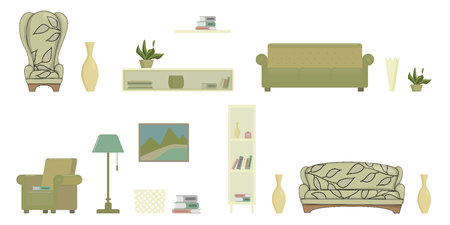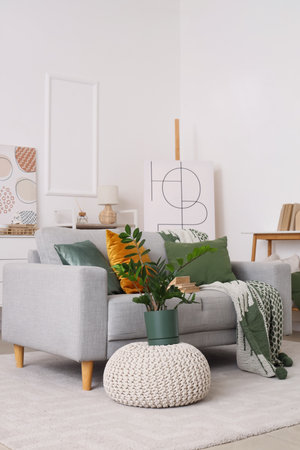Understanding Maximalism in British Homes
Maximalism has seen a remarkable resurgence in British interior design, particularly within smaller homes and flats where every inch is precious. Unlike the minimalist ethos that dominated UK interiors in previous decades, maximalism celebrates abundance—layering patterns, colours, textures, and cherished objects to create spaces brimming with personality. The British take on maximalism is deeply rooted in both history and a penchant for storytelling through interiors. Traditional influences such as Victorian ornamentation and Arts & Crafts motifs continue to inspire today’s designers and homeowners, offering a rich tapestry of references from florals to chintz, heritage wallpapers to boldly upholstered furniture. Contemporary British maximalism often mixes this nostalgia with global influences, eclectic art collections, and a tongue-in-cheek approach that feels playful yet curated. The result is a uniquely British expression of maximalist style: not merely clutter or chaos, but an intentional curation of colour and character that reflects the stories and passions of those who live there. For UK homeowners navigating small spaces, understanding these cultural nuances helps inform colour choices that are both vibrant and harmonious—a foundational step before delving into more practical colour principles for maximalist living.
2. Colour Psychology and Mood in Compact Spaces
Understanding how colour choices influence mood and spatial perception is vital for UK homeowners working with typically modest room sizes. In maximalist small spaces, the interplay between bold hues and limited square footage can either invigorate or overwhelm. British homes, often characterised by cosier dimensions, benefit from a thoughtful approach to colour psychology, balancing personal expression with comfort.
How Colour Impacts Atmosphere in Small UK Homes
The right palette can make a compact space feel vibrant yet harmonious. Warm colours like terracotta, mustard yellow, or deep coral add energy but may visually draw walls inwards if overused. Cooler tones such as sage green or dusky blue tend to recede, creating an illusion of depth that suits smaller rooms. Layering these shades with intention allows homeowners to evoke specific moods—energising kitchens or restful bedrooms—without sacrificing the sense of openness.
Perception of Space: The Role of Tone and Saturation
It’s not just about the base colour; tone and saturation matter greatly. Lighter tints can reflect natural light more effectively, making tight spaces feel airier—a frequent need in Britain’s often grey climate. Conversely, richer hues introduce drama and personality, anchoring maximalist schemes while providing visual interest through contrast.
Quick Reference: Colour Effects Table for Small UK Spaces
| Colour Type | Psychological Effect | Best Use In Maximalism |
|---|---|---|
| Warm (Red, Orange) | Energising, Cosy | Accent walls or soft furnishings to avoid crowding |
| Cool (Blue, Green) | Calming, Expansive | Main wall colours or large-scale patterns for spaciousness |
| Muted/Soft Pastels | Soothed mood, Light-enhancing | Backgrounds for layering bolder accessories/artwork |
| Deep/Dark Tones | Dramatic, Intimate | Nooks or feature elements to create focal points |
When crafting a maximalist scheme within the confines of a British home, consider not only your favourite shades but also how their psychological properties will interact with available light and room proportions. This mindful approach ensures that even the boldest choices contribute positively to atmosphere—creating inviting, expressive environments that celebrate both individuality and comfort.

3. Layering British-Inspired Colour Palettes
When working with maximalist style in compact UK homes, the art of layering colour is essential. Begin by drawing inspiration from quintessentially British environments—think the deep greens of the Lake District, the rich reds and golds of Victorian brickwork, or the muted blues and greys that echo a Cornish coastline. These references not only connect your space to local heritage but also offer a tried-and-tested palette that feels familiar yet striking.
To achieve depth without overwhelming a small space, start with a base tone drawn from traditional British architecture—a warm stone beige, slate grey, or chalky white. Use this as your canvas. Next, introduce richer hues as accents: perhaps a mustard yellow reminiscent of Cotswold cottages or a regal navy blue that nods to London’s historic townhouses. Patterned textiles are invaluable here; layer tartan throws, William Morris-inspired wallpapers, or geometric rugs for visual interest. The key is to mix scales—pair bold florals with finer pinstripes or checks—to avoid visual clutter while still celebrating maximalism.
Don’t shy away from metallics and gloss finishes either; brass light fixtures or lacquered side tables can reflect natural light and help open up tight corners. Finally, take cues from local traditions when combining colours: harmonise unexpected combinations such as sage green with blush pink (a classic garden pairing) or oxblood red with duck egg blue (seen in Edwardian interiors). By layering these British-inspired hues thoughtfully, you’ll create a maximalist small space that feels both rooted in place and refreshingly modern.
4. Balancing Bold Statements With Cohesion
Embracing maximalist colour in small UK homes is a thrilling venture, but too much intensity can quickly overwhelm compact spaces. The key lies in blending vibrant hues with strategic cohesion, ensuring each element feels intentional rather than chaotic.
Techniques for Harmonising Bold Colours
Start by establishing a core palette of two or three main colours. These form your base and help anchor more exuberant accents. Use accent walls wisely—painting one wall in a rich emerald or navy offers impact without enclosing the room. Complement this with soft furnishings such as cushions, throws, and rugs that echo or contrast your chosen shades, providing continuity without monotony.
Breaking Up Visual Intensity
Incorporate neutral elements and natural textures to break up blocks of strong colour. Pale flooring, white skirting boards, or wooden furniture can introduce breathing space, making bold statements feel curated rather than cluttered. Pattern also plays a crucial role; mix florals with geometrics or stripes sparingly to add visual interest while maintaining order.
Practical Tips Table: Blending Colour in Compact Maximalism
| Technique | Description | UK Home Example |
|---|---|---|
| Accent Wall | Paint one feature wall in a vivid shade | Deep teal behind a velvet sofa in a Victorian terrace lounge |
| Soft Furnishings | Add cushions/throws in complementary colours or patterns | Mixing ochre and plum cushions on a grey settee in a London flat |
| Visual Breaks | Use pale floors and light trims to calm the palette | Scandi-style oak flooring with bold patterned wallpaper in a Bristol kitchen diner |
| Layered Patterns | Combine different prints thoughtfully for depth | A floral armchair paired with striped curtains in a cottage snug |
Cohesion is ultimately about rhythm and repetition: repeat key colours and motifs at intervals around the room so the eye naturally moves from one area to another. This technique prevents any single bold element from dominating and ensures your maximalist haven feels lively yet harmonious—a perfect fit for stylish UK small-space living.
5. Maximalist Colour Application: Curated Case Studies
Real UK Homes: Bold Choices in Compact Spaces
Across the UK, homeowners have increasingly embraced maximalism, using colour as a key tool to transform their small spaces into vibrant, personality-filled sanctuaries. Take, for instance, a North London terrace where the living room bursts with jewel-toned walls and mismatched patterned furnishings. The homeowner reports that layering deep greens and sapphire blues created depth and an inviting warmth, offsetting the rooms modest dimensions. Key lesson: Dont shy away from strong colours—when thoughtfully paired with contrasting trims or neutral floors, they can expand the perceived boundaries of a room.
Common Pitfalls and How to Avoid Them
However, not every attempt at maximalist colour succeeds without careful planning. In one Bristol flat, an overzealous use of clashing primary hues on all surfaces led to visual chaos and discomfort. The owner eventually repainted ceilings white and introduced a unifying accent colour through soft furnishings to restore balance. Lesson learned: Even maximalism benefits from restraint—select two or three dominant shades and let them echo throughout the space rather than competing on every surface.
Successful Layering in Kitchens and Bedrooms
A Brighton kitchen provides another instructive case. Here, mustard yellow cabinetry is juxtaposed with teal splashbacks and vintage floral wallpaper. The effect is cheerful yet cohesive because metallic hardware and wooden accents serve as grounding elements. Similarly, a compact Manchester bedroom features layers of terracotta, blush pinks, and burnt orange textiles against a navy feature wall—a combination that feels curated rather than chaotic thanks to consistent undertones. Both examples highlight the importance of harmonising warm or cool tones for a visually pleasing result.
Takeaways for UK Homeowners
These real-life stories underline several crucial points: test colours in natural light before committing; balance boldness with areas of visual rest; and use accessories or artwork to tie disparate hues together. By learning from both the successes and missteps of fellow UK homeowners, you can confidently harness maximalist colour principles—turning even the smallest space into a uniquely expressive home.
6. Local Resources and Sustainable Choices
Bringing maximalist colour schemes to your small UK home isn’t just about selecting the right shades—it’s also about choosing materials and accessories that are both locally sourced and environmentally responsible. By supporting British businesses, you not only reduce your carbon footprint but also discover products that are uniquely tailored to the UK climate and living styles.
Finding Paints & Wallpapers
Start by exploring independent paint brands such as Farrow & Ball, Little Greene, or Earthborn. These companies offer a broad spectrum of bold colours suitable for maximalist interiors, with many ranges boasting eco-friendly credentials like low VOCs and water-based formulations. For wallpaper, British makers like Graham & Brown or Cole & Son provide rich patterns inspired by both traditional and contemporary design sensibilities. Many local shops are happy to supply samples so you can experiment before committing.
Shopping Locally for Accessories
When it comes to accessories—think cushions, rugs, lampshades, and ceramics—consider browsing local markets, artisan fairs, or independent boutiques in your area. Websites such as Not On The High Street and Folksy connect you directly with UK designers and makers. This approach ensures your space is filled with unique finds while supporting the domestic creative economy.
Sustainable Practices to Keep in Mind
Where possible, prioritise upcycled or vintage pieces from charity shops or reclamation yards; these add character and help minimise waste. Choose natural materials (like wool throws or wooden frames) over synthetics when available. Finally, dispose of any leftover paint responsibly at council-run recycling centres, and donate surplus wallpaper to community projects or schools.
By sourcing locally and making sustainable choices, you not only enrich the story of your home but also contribute positively to the environment—a principle perfectly aligned with the thoughtful exuberance of maximalist design in UK small spaces.


